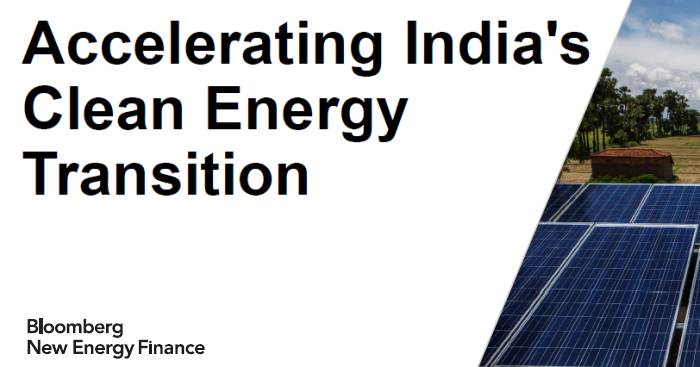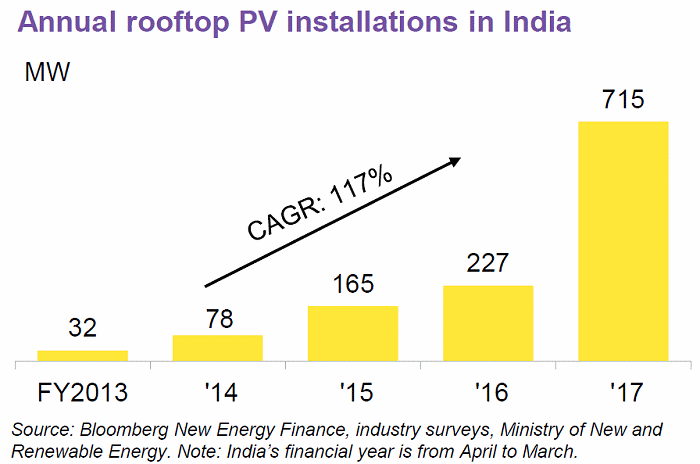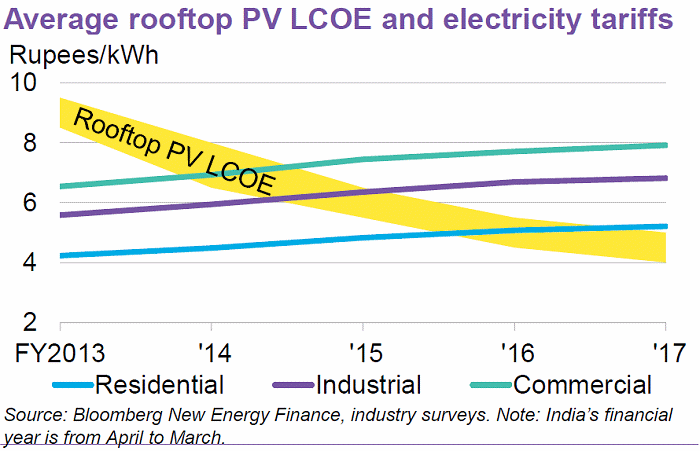
India’s rapid growth in rooftop solar panel installations isn’t fast enough to meet the nation’s goals says a new report from Bloomberg New Energy Finance.
India has seen a 117% compound annual growth rate in rooftop PV since April 2013 and 715MW of rooftop solar was installed this financial year. While India achieved a cumulative installed capacity of 1.3GW at the end of FY2017, this was just 3% of its target capacity addition of 40GW by FY2022.

BNEF says India will need to invest USD $23 billion over the next five years to meet that target.
The 40GW target is certainly achievable as there are plenty of opportunities in the nation. The cost of electricity from rooftop solar has also plummeted by 50% in the last five years says BNEF. Meanwhile, average retail electricity rates have increased by 22% in the same period, making rooftop PV cheaper than commercial and industrial grid electricity tariffs in all major states in the country.
Based on space and self-consumption constraints, BNEF estimates sectors (including residential) currently using back-up diesel could host 60GW of PV. Additionally, around 8 million irrigation pumps currently powered by diesel could be economically replaced by solar-powered pumps.
BNEF believes residential installations will increase their share in India’s rooftop PV markets, driven by an increase in awareness, socket parity1 and as households seek a more reliable electricity supply. To accelerate this, BNEF says broader application of net metering is required to make going solar more financially viable for households.
Other issues holding back the residential sector have included the high upfront cost for home solar power systems, a shortage of financing options and grid electricity still being cheaper for residential consumers that have low energy consumption.
According to the World Bank, per capita electricity consumption in India in 2014 was just 806 kilowatt-hours. In the same year in Australia, it was 10,078 kWh. However, while Australia’s per capita figure has flattened, India’s is rapidly rising as more of its citizens gain access to electricity and more devices are used.

Bloomberg says the levelised cost of energy (LCOE) of rooftop PV in India for residential and commercial customers is now among one of the lowest in the world and comparable only to some of the sunniest parts in Australia and U.S. However, household incomes are much lower, which makes acquisition of home solar power systems far more challenging and hence the need for innovative financing options that can still provide electricity cheaper than from the mains grid.
The BNEF report, Accelerating India’s Clean Energy Transition, can be downloaded here (PDF).
Footnotes
- “Socket parity” is where home rooftop solar electricity works out to be the same price as electricity that a consumer purchases from an energy retailer ↩

 RSS - Posts
RSS - Posts



Speak Your Mind